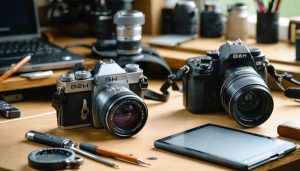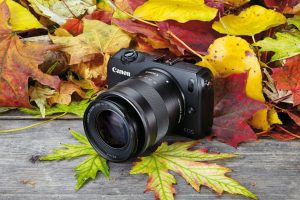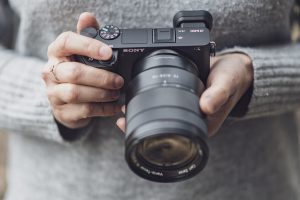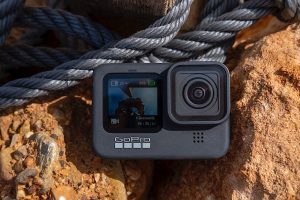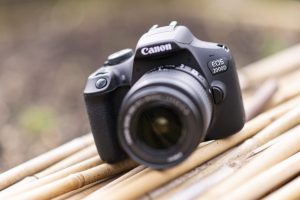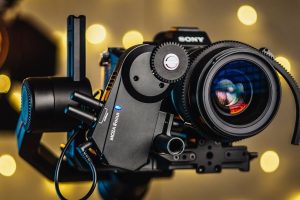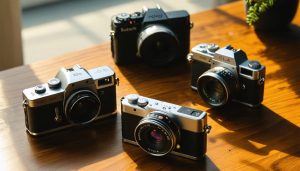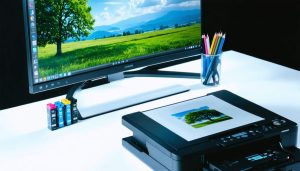
Pocket cameras from the 1960s through 1990s revolutionized everyday photography by delivering remarkable image quality in devices small enough to slip into a jacket. These compact marvels—think Olympus XA, Rollei 35, or Minox 35—combined ingenious engineering with genuinely capable optics, often matching their larger SLR cousins in sharpness while weighing a fraction as much.
Today’s resurgence in film photography has transformed these once-common cameras into sought-after tools. A well-maintained Ricoh GR1 or Contax T2 delivers images with character that digital sensors struggle to replicate: organic grain structure, nuanced color rendering, and that indefinable quality collectors call “soul.” Unlike bulky medium format cameras, vintage pocket cameras encourage spontaneous shooting—the same advantage that made them popular decades ago.
Understanding what separates collectible gems from disposable relics requires knowledge of specific models, their mechanical quirks, and realistic market values. A $30 point-and-shoot might surprise you with its lens quality, while a $500 premium compact could need expensive repairs within months. The condition of light seals, battery availability, and lens coatings dramatically affects both usability and value.
Whether you’re a collector pursuing rare variants, a film photographer seeking an everyday carry camera, or a newcomer curious about analog photography’s appeal, vintage pocket cameras offer an accessible entry point. This guide covers identification strategies, maintenance essentials, shooting techniques, and practical buying advice to help you navigate this fascinating intersection of photography history and contemporary creative practice.
What Exactly Is a Vintage Pocket Camera?
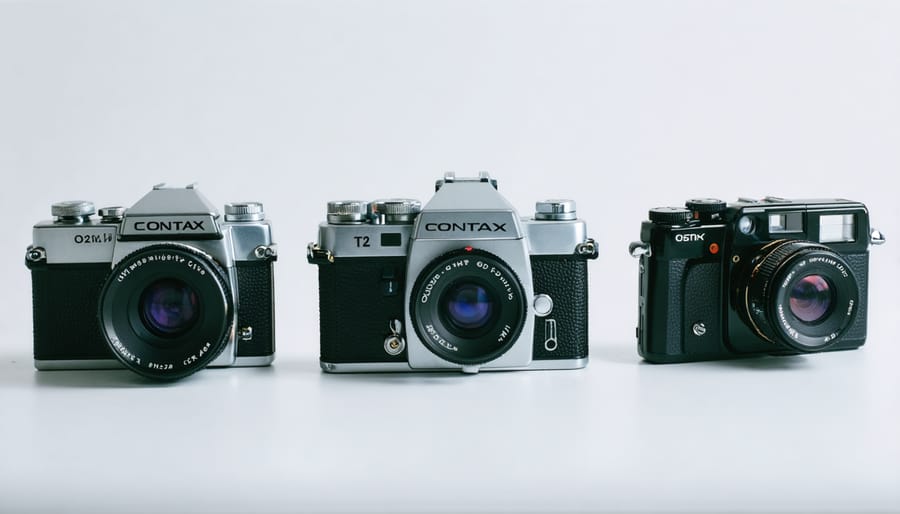
The Golden Age: 1980s to Early 2000s
The period from the 1980s to early 2000s represents the pinnacle of pocket camera design, when manufacturers perfected the balance between portability and performance. This golden age gave us some of the most sought-after compact cameras on today’s vintage market.
The decade began with simple zone-focus models like the Olympus XA series, which relied on manual distance estimation. These cameras proved that serious image quality didn’t require bulk. By the mid-1980s, autofocus technology had miniaturized enough to fit in shirt pockets, revolutionizing snapshot photography. The Canon Sure Shot and Nikon One Touch series brought sophisticated focusing systems to everyday users.
The 1990s saw camera makers race to add features while maintaining compact dimensions. Built-in flash units became standard, eliminating the need for external accessories. Premium models like the Contax T2 and Ricoh GR1 featured exceptional optics rivaling some SLR lenses, making them favorites among professional photographers who needed a reliable backup or street photography tool.
What makes cameras from different eras collectible varies considerably. Early 1980s models appeal to minimalists who appreciate their mechanical simplicity and fully manual controls. Mid-period cameras from the late 1980s offer the sweet spot of reliability and features without excessive automation. High-end models from the late 1990s, though more complex electronically, deliver image quality that still impresses today.
The titanium-bodied Contax T series and Leica Minilux command premium prices due to their legendary build quality and optical performance. Meanwhile, workhorses like the Olympus Stylus Epic remain affordable yet highly capable, making them perfect entry points for vintage compact photography.
Premium vs. Budget Models: What’s the Difference?
Not all vintage pocket cameras are created equal, and understanding the distinction between premium and budget models can significantly impact your shooting experience and investment decisions.
Premium pocket cameras from manufacturers like Rollei, Minox, and Contax were engineering marvels designed for discerning photographers. Take the Rollei 35 series as a prime example. These German-made cameras featured exceptional Tessar or Sonnar lenses capable of producing sharp, contrasty images that rival many larger format cameras. The build quality was superb, with metal bodies, precisely engineered mechanisms, and smooth, reliable controls. When you pick up a Rollei 35, you immediately feel the difference—it has a reassuring weight and solidity that speaks to its craftsmanship. These premium models typically commanded prices equivalent to several weeks’ wages when new, and they’ve held up remarkably well over time.
On the other end of the spectrum, budget consumer models like the Kodak Disc cameras, basic Instamatic models, or simple fixed-focus plastic compacts served the mass market. These cameras prioritized affordability and ease of use over image quality. They often featured inexpensive plastic lenses, basic exposure systems, and less durable construction. A Kodak Ektra camera from the budget line, for instance, might have a simple plastic lens and limited manual controls.
The practical difference becomes apparent when you develop your first roll. Premium models deliver images with excellent sharpness, pleasing color rendition, and good low-light performance. Budget models produce softer images with more distortion and limited dynamic range. For collectors, premium cameras maintain stronger resale values and offer more satisfying shooting experiences. However, budget models can still be fun learning tools and conversation pieces, especially if you’re just exploring vintage photography without significant financial commitment.
The Cult Classics: Most Sought-After Vintage Pocket Cameras
The Contax T Series: The Luxury Standard
When photographers talk about the ultimate pocket camera, the Contax T series invariably enters the conversation. The Contax T2, released in 1990, and its successor the T3 from 2001, represent what many consider the apex of compact camera design.
What sets these cameras apart is their remarkable Carl Zeiss Sonnar 38mm f/2.8 lens, which delivers sharpness and contrast that rival many professional setups. The titanium body construction feels substantial in hand, a far cry from the plastic compacts that flooded the market during the same era. Both models feature sophisticated metering systems and aperture-priority modes that give you creative control while maintaining point-and-shoot convenience.
The T2 became a cultural icon, spotted in the hands of fashion photographers and artists who appreciated its blend of portability and optical excellence. Real-world users consistently praise its ability to capture street photography with incredible detail and beautiful color rendition on slide film.
Today, these cameras command premium prices. Expect to pay $800-1,500 for a working T2, while the T3 can fetch $1,200-2,000 or more. Like many vintage cameras worth thousands, condition dramatically affects value. Finding one with a functional LCD and clean lens is increasingly challenging, making them serious investments for collectors and working photographers alike.
Olympus Stylus Epic (mju-II): The People’s Champion
If there’s one vintage pocket camera that punches far above its weight class, it’s the Olympus Stylus Epic, known as the mju-II in international markets. Released in 1997, this unassuming clamshell camera became the darling of street photographers and travel enthusiasts who valued image quality over camera prestige.
The secret to its cult status lies in that remarkably sharp 35mm f/2.8 lens. Despite being a point-and-shoot, the optics deliver results that surprise even seasoned photographers accustomed to professional gear. Images exhibit excellent edge-to-edge sharpness and pleasant color rendition, making the Epic a genuine workhorse for documentary photography.
In real-world shooting, the camera disappears into your workflow. The autofocus locks quickly in most lighting conditions, though it struggles predictably in dim environments. The maximum f/2.8 aperture helps capture usable images in low light where competing cameras fail entirely. The weather-resistant construction means you can shoot in light rain without anxiety, a rare feature in compact film cameras.
Street photographers love its discrete size and quiet shutter, allowing candid captures without drawing attention. The automatic exposure system proves surprisingly reliable, though you sacrifice manual control for convenience. Battery consumption remains reasonable, and the camera accepts common CR123A cells available anywhere.
Today’s enthusiasts appreciate the Epic as an everyday carry camera that delivers professional-looking results without the bulk or complexity of SLR systems.
Ricoh GR Series: The Street Photography Secret
The Ricoh GR series represents one of those rare instances where street photographers and photojournalists collectively agree on a single camera system. The GR1, introduced in 1996, along with its successors the GR1s and GR1v, pack a genuinely sharp 28mm f/2.8 lens into a body that slips into a jacket pocket without complaint.
What makes these cameras special isn’t flashy features but consistent performance. The lens renders images with remarkable clarity across the frame, while the quick autofocus and responsive controls let you capture moments as they unfold. The GR1v added snap-focus capability, allowing you to preset focus distances for ultra-fast zone focusing on the street.
Documentary photographers gravitate toward these cameras because they’re discreet, reliable, and produce results that hold up in professional contexts. The 28mm focal length offers enough environmental context without the distortion of wider lenses, making it ideal for capturing authentic street scenes.
Finding a working GR1 requires patience. Check that the lens extends and retracts smoothly without grinding sounds, test all shutter speeds, and verify the autofocus responds quickly. These cameras used plastic gears that can wear over time. Expect to pay between 300 and 600 dollars for clean examples, with the GR1v commanding premium prices. Buy from reputable sellers who offer return policies, as internal issues aren’t always immediately apparent.
Hidden Gems Worth Hunting For
While collectors chase Contax T2s and Leica Miniluxes at inflated prices, savvy photographers are discovering equally capable alternatives flying under the radar. These Japanese vintage cameras deliver premium results without the premium price tags.
The Nikon 35Ti and 28Ti deserve serious consideration for their exceptional 35mm f/2.8 and 28mm f/2.8 lenses respectively. Both feature titanium bodies, sophisticated metering systems, and produce images rivaling cameras costing three times as much. The 35Ti particularly excels in low light, making it perfect for street photography.
Minolta’s TC-1 remains criminally undervalued despite housing a stellar 28mm f/3.5 G-Rokkor lens. This ultra-compact gem produces sharp, contrasty images with beautiful color rendition. Its small size makes it genuinely pocketable, yet the build quality feels reassuringly solid.
The Konica Big Mini series offers remarkable value for beginners. The BM-301’s 35mm f/3.5 lens punches well above its weight class, delivering sharp results across the frame. It’s an ideal entry point without sacrificing image quality.
Canon’s Sure Shot series, particularly the Supreme and Sleek models, provide reliable performance at bargain prices. While lacking the prestige of their pricier siblings, these cameras feature quality optics and intuitive controls that simply work.
Why Shoot with a Vintage Pocket Camera Today?
The Image Quality Argument
One of the most compelling reasons photographers return to vintage pocket cameras is the distinctive image quality they deliver. When you pair quality film stocks like Kodak Portra or Fuji Provia with the surprisingly capable glass found in premium compact cameras, the results often surprise even seasoned digital shooters.
The character of film images differs fundamentally from digital captures. Film grain has an organic, three-dimensional quality that many find more aesthetically pleasing than digital noise. Colors respond differently too, with film typically rendering skin tones with a warmth and smoothness that requires extensive post-processing to replicate digitally. The dynamic range of modern color negative film is genuinely impressive, often holding detail in both highlights and shadows that challenges entry-level digital cameras.
Real-world comparisons reveal these differences clearly. Shoot a portrait with a Contax T2 on Portra 400, and you’ll notice how the film naturally compresses highlights on a subject’s face, creating a flattering glow rather than harsh clipping. Landscape photographers often praise slide films like Velvia for their rich, saturated colors that pop without appearing artificial.
The limitations themselves create opportunities. Film’s highlight roll-off encourages thoughtful exposure decisions, while grain structure adds texture that complements certain subjects beautifully. These aren’t defects to overcome but distinctive characteristics that shape your creative vision.
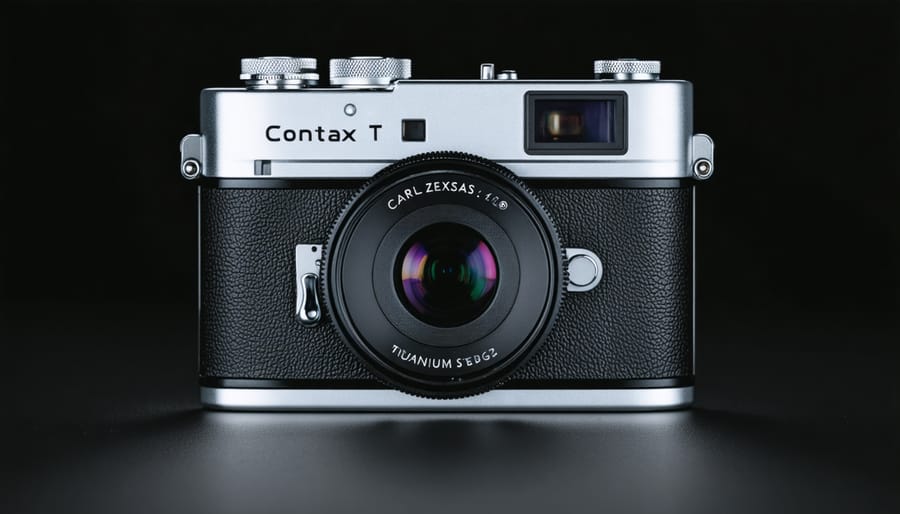
Simplicity and Creative Constraints
There’s something liberating about shooting with a vintage pocket camera that forces you to think differently. Unlike modern digital cameras with dozens of menu options and customizable settings, these compact film cameras typically offer just a handful of controls—sometimes just a shutter button and perhaps a focus zone selector. This apparent limitation actually becomes a creative advantage.
When you can’t endlessly fiddle with ISO, white balance, or picture profiles, you’re free to concentrate on what truly matters: composition, lighting, and timing. I’ve watched photographers spend precious moments adjusting settings while a perfect candid moment disappears. With a vintage pocket camera, you’re already ready to shoot.
The finite number of exposures on a film roll—typically 24 or 36 frames—adds another valuable constraint. You become more intentional with each shot, carefully considering whether a scene is worth capturing. This mindfulness often leads to stronger photographs than the spray-and-pray approach enabled by unlimited digital storage.
Think of it as creative training wheels in reverse. Instead of adding complexity as you improve, you’re stripping away distractions to focus on photographic fundamentals. Many professional photographers regularly return to simple pocket cameras precisely for this reason—they’re reminded that great images come from vision and timing, not from having the most adjustable equipment.
Portability Without Compromise
The defining charm of vintage pocket cameras lies in their genuine portability. We’re talking about cameras that actually slip into a jacket pocket or small purse without weighing you down. Most models from the 1960s through 1990s tip the scales at just 6-10 ounces, making them barely noticeable during a full day of shooting.
Consider the Olympus XA series, which measures roughly 4 inches wide and weighs about 8 ounces with film loaded. You can carry one everywhere without the neck strain or shoulder fatigue that comes with larger camera systems. This makes them ideal companions for street photography, where being inconspicuous matters, or travel situations where every ounce counts in your luggage.
The compact size doesn’t mean sacrificing image quality either. Many of these cameras feature sharp 35mm or 40mm lenses that produce excellent results on film. The Rollei 35, despite being one of the smallest 35mm cameras ever made, houses a premium Tessar or Sonnar lens that rivals much larger equipment.
For everyday carry, these cameras encourage spontaneous photography. When your camera weighs less than your smartphone and fits in the same pocket, you’re more likely to have it when unexpected moments appear. That’s the real advantage: being ready without feeling burdened by gear.
Smart Buying: How to Find and Evaluate Vintage Pocket Cameras
Where to Find Them
Finding vintage pocket cameras requires knowing where to look and understanding the trade-offs of each source. Online marketplaces like eBay offer vast selection and competitive pricing, making them ideal for comparing models and finding deals. However, you can’t physically inspect cameras before buying, so carefully review seller ratings and return policies. Etsy caters more to collectors seeking aesthetic pieces, though functional cameras appear regularly with detailed photos.
Specialty dealers like KEH Camera and Japan Camera Hunter provide professionally tested equipment with warranties, eliminating much of the guesswork. You’ll pay premium prices, but the peace of mind is worth it for beginners or those seeking specific models in guaranteed working condition. KEH’s grading system is particularly transparent, helping you understand exactly what condition to expect.
Local thrift stores and estate sales are treasure hunts where patience pays off. Prices are typically low, but cameras may need servicing or repairs. These venues work best if you know what to look for and can test basic functions on-site. Bring a smartphone to research unfamiliar models quickly.
Flea markets and vintage camera shows offer middle ground between online convenience and hands-on inspection. You can handle cameras, negotiate prices, and often chat with knowledgeable sellers who share maintenance tips and shooting advice specific to each model.
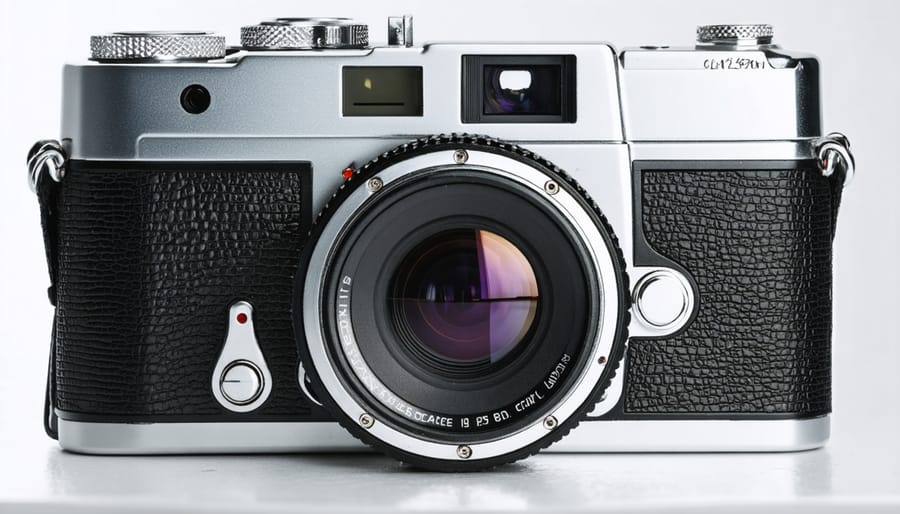
Critical Things to Check Before Buying
Before handing over your cash for that charming vintage pocket camera, a thorough inspection can save you from expensive disappointments. Start by examining the lens carefully under good light. Look for lens fungus, which appears as web-like patterns or spots inside the glass elements. While minor haze might be cleanable, significant fungus growth is often a deal-breaker. Check for scratches on the front element by tilting the camera under light—surface scratches are manageable, but deep gouges affect image quality.
Test the shutter at all speeds if possible. Fire it multiple times listening for consistent sounds and watching for smooth operation. Sticky or hesitant shutters need professional attention but are usually repairable.
Inspect light seals around the film door and back. These foam strips deteriorate over time, appearing as sticky black residue. Good news: replacing light seals is an inexpensive DIY fix, so don’t let degraded seals stop you from buying an otherwise solid camera.
Open the battery compartment and look for corrosion—white or green crusty deposits that indicate leaked batteries. Minor corrosion can be cleaned, but severe damage affecting contacts is problematic.
For autofocus models, test the focus mechanism across different distances. Sluggish or non-functioning autofocus often requires specialized repair. Similarly, pop the flash several times to ensure it charges and fires consistently. Flash repairs can be complex and costly, so factor this into your negotiation if it’s not working perfectly.
Price Expectations and Market Trends
The vintage pocket camera market has evolved significantly, with prices ranging from surprisingly affordable to eye-wateringly expensive depending on model and condition. You’ll find working examples of common cameras like the Olympus XA or Canon Sure Shot in the $50-150 range, representing excellent entry points for newcomers. Mid-tier classics such as the Contax T2 or Minolta TC-1 typically command $300-600 for well-maintained examples.
However, certain models have experienced price inflation driven by social media hype and influencer endorsements. The Yashica T4 and T5, once $100 cameras, now regularly sell for $400-800, while the Contax T3 can exceed $1,500. These inflated prices often don’t reflect proportional improvements in image quality compared to more affordable alternatives.
To spot fair deals, research completed eBay listings rather than current asking prices, and cross-reference multiple platforms. Be wary of listings with stock photos instead of actual camera images, vague condition descriptions, or sellers unfamiliar with camera functionality. Working light seals, clean lens elements, and functioning electronics justify higher prices. Conversely, cosmetic mint condition shouldn’t drastically increase value if mechanical function is compromised. Patient buyers willing to look beyond hyped models often discover exceptional image-makers like the Ricoh GR1 or Konica Big Mini at reasonable prices.
Actually Using Your Vintage Pocket Camera
Film Choices That Complement These Cameras
Choosing the right film for your vintage pocket camera can dramatically impact your results, and thankfully, these compact shooters are remarkably forgiving. Color negative film remains the most versatile choice for pocket cameras, with Kodak Gold 200 or Fujicolor C200 offering excellent latitude that forgives exposure errors common with basic metering systems. These emulsions handle mixed lighting gracefully and scan beautifully for digital sharing.
For photographers seeking more saturated, punchy colors, slide film like Fujichrome Velvia 50 or Kodak Ektachrome E100 creates stunning results, though these demand more precise exposure. The inherent softness of many pocket camera lenses actually complements the richness of slide film nicely, creating a dreamy quality rather than clinical sharpness.
Black and white shooters should consider Ilford HP5 Plus 400 or Kodak Tri-X 400 for their flexibility across lighting conditions. The grain structure pairs beautifully with the character of vintage optics, emphasizing texture over technical perfection.
Regarding ISO selection, stick with 200-400 speed films for general use. While your camera might have ISO 100 settings, faster films provide insurance against underexposure in typical shooting situations. Indoor photography benefits from 400-speed options, though don’t expect miracles in low light without flash. Remember, these cameras were designed for casual snapshots in good lighting, so embrace their limitations rather than fighting them.

Basic Maintenance and Care
Keeping your vintage pocket camera functional requires gentle care and realistic expectations. Start with lens cleaning—use a rocket blower to remove loose dust, then apply lens cleaning fluid sparingly to a microfiber cloth, never directly on the glass. Work in circular motions from center outward. For stubborn fungus or haze, professional intervention is necessary to avoid damaging lens coatings.
Battery replacement often presents challenges since many vintage cameras used mercury cells now banned for environmental reasons. Fortunately, modern alkaline or zinc-air alternatives like the Wein Cell provide similar voltage. Check online forums for your specific model’s battery equivalent, as voltage mismatches can affect light meter accuracy.
Store cameras in a cool, dry environment with 40-50% humidity. Silica gel packets help prevent fungus growth, particularly damaging in humid climates. Exercise shutters every few months to prevent lubricants from hardening—fire the shutter at various speeds without film loaded.
For comprehensive guidance on preserving these mechanical treasures, explore our detailed film camera maintenance resource.
Seek professional repair for sticky shutters, light seal deterioration, or rangefinder misalignment. While many pocket cameras lasted decades with minimal care, expect occasional servicing. These mechanical marvels can provide years of reliable shooting when treated respectfully and maintained thoughtfully.
Working Around Common Limitations
Vintage pocket cameras come with personality quirks that require creative workarounds. The most common frustration is passive autofocus systems that struggle in low light or with low-contrast subjects. If your camera hunts endlessly for focus, try aiming at a high-contrast edge at the same distance as your subject, half-pressing the shutter to lock focus, then recomposing your shot. This technique works wonders for those finicky early 1990s point-and-shoots.
Automatic exposure systems in these cameras often get confused by backlit scenes or strong highlights. When shooting someone with a bright window behind them, get closer to fill the frame with your subject, lock exposure with a half-press, then step back to your desired composition. The camera’s meter will prioritize the person rather than blowing them out into a silhouette.
Built-in flash on vintage compacts is notoriously harsh and causes red-eye. Position subjects at least eight feet away when possible, and if your camera has a red-eye reduction mode, use it despite the delay. Alternatively, increase surrounding ambient light and let the camera’s auto settings reduce flash output naturally. For close-ups, try diffusing the flash with a single layer of white tissue secured with tape—it softens the light remarkably without confusing the exposure system.
Vintage pocket cameras represent more than nostalgia—they’re remarkably capable photographic tools that still deliver exceptional results today. Whether you’re drawn to the mechanical precision of a Rollei 35, the surprising quality of an Olympus XA, or the pocketable convenience of a Minox 35, these cameras offer something modern digital gear often lacks: a tangible, intentional connection to the photographic process. For collectors, they’re beautifully engineered artifacts from an era when compactness required genuine innovation rather than miniaturized electronics. For active photographers, they’re liberating companions that slip into a jacket pocket yet produce images with character and resolution that can surprise even seasoned shooters.
The real magic happens when you embrace both aspects. Don’t just display your camera collection on a shelf—load them with film and take them into the world. These cameras were designed to be used, and sitting idle for decades actually harms their mechanisms more than regular exercise does. Start with one reliable model, learn its quirks, and experience how limitations breed creativity. You’ll quickly understand why photographers chose these specific cameras during analog photography’s golden age.
The beauty of vintage pocket cameras is that they’re still accessible, relatively affordable, and increasingly appreciated. As you explore this world, remember that the best camera is always the one you have with you—and these compact classics make that philosophy effortlessly achievable.



